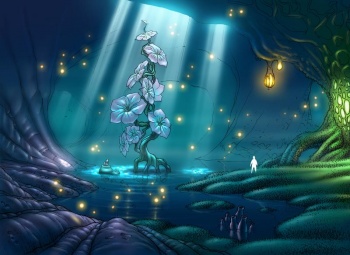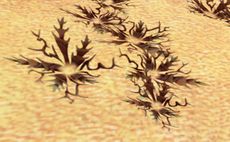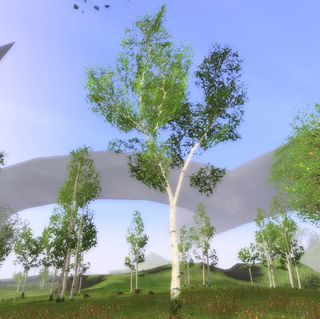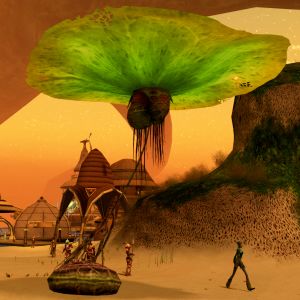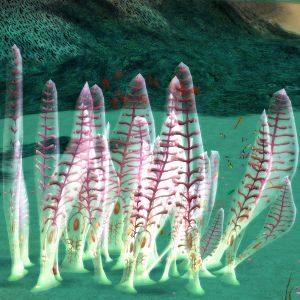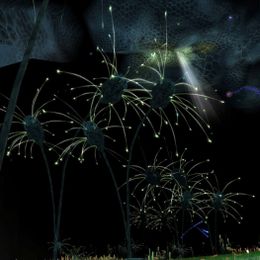Aus EnzyklopAtys
Leda (Diskussion | Beiträge) |
Leda (Diskussion | Beiträge) K (→Wald) |
||
| Zeile 28: | Zeile 28: | ||
== [[Wald]] == | == [[Wald]] == | ||
[[File:Angelio-Summer-L.jpg|320px|thumb|right|Angelio]] | [[File:Angelio-Summer-L.jpg|320px|thumb|right|Angelio]] | ||
| − | *'''[[Alinea]]''' - | + | *'''[[Alinea]]''' - ein nadeltragender Baum, der oft die Form von zwei sich umeinander windenden Bäumen hat. |
| − | *'''[[Angelio]]''' - | + | *'''[[Angelio]]''' - ein kleiner Baum mit schöner weißer Rinde und rosa Blüten im Frühling. |
| − | *'''[[Arino]]''' - | + | *'''[[Arino]]''' - ein farnartiger Strauch mit großen Blättern. |
| − | *'''[[Balogna]]''' - | + | *'''[[Balogna]]''' - ein dichter Strauch, dessen Blätter sich spiralförmig nach oben winden. |
| − | *'''[[Bolka]]''' - | + | *'''[[Bolka]]''' - riesiger Baum, den die Matis für Häuser und andere Gebäude verwenden |
| − | *'''[[Campana]]''' - | + | *'''[[Campana]]''' - eine kleine krautige Pflanze, deren Blüten Teil der Zusammensetzung des "Löwenzahnweins" sind. |
| − | *'''[[Crolice]]''' - | + | *'''[[Crolice]]''' - kommt in Form von riesigen Ästen aus dem Boden geschlängelt. |
| − | *'''[[Dorio]]''' - | + | *'''[[Dorio]]''' - eine Dorotea in einem früheren Stadium des Wachstums. |
| − | *'''[[Dorotea]]''' - | + | *'''[[Dorotea]]''' - ein dickerer und noch höherer Cousin des Dorio, der höchste Baum auf Atys. |
| − | *'''[[Fongice]]''' - | + | *'''[[Fongice]]''' - ein riesiger Pilz, höher als die meisten Homins. |
| − | *'''[[Fragaria]]''' - | + | *'''[[Fragaria]]''' - oder '''[[Rosae Matia]]''', eine kleine krautige Pflanze, die sehr zuckerhaltige rote Früchte trägt. |
| − | *'''[[Irena]]''' - | + | *'''[[Irena]]''' - ein niedriger Strauch, der nicht höher als ein hochgewachsener Mensch wird. |
| − | *'''[[Iriscea]]''' - | + | *'''[[Iriscea]]''' - wird '''Faham''' genannt, wenn sie im Dschungel wächst und ist auch als '''[[Endilweis]]''' bekannt. |
| − | *'''[[Maydea]]''' - | + | *'''[[Maydea]]''' - ein Gras, das in den feuchtesten Gebieten des Waldes wächst. |
| − | *'''[[Pepo]]''' - | + | *'''[[Pepo]]''' - eine Pflanze aus der gleichen Familie wie der Sparàn der Seen. |
| − | *'''[[Pocea]]''' - | + | *'''[[Pocea]]''' - oder '''[[Mühlenperle]]''', ein Gras, dessen winzige Samen sich in einer hängenden Fahne sammeln, die im Dschungel '''ba-che''' genannt wird. |
| − | *'''[[Salina]]''' - | + | *'''[[Salina]]''' - ein niedriger, nachdenklicher Baum, der über eine große Fläche Schatten spendet. |
| − | *'''[[Volacea]]''' - | + | *'''[[Volacea]]''' - eine krautige Pflanzenart, deren Größe und Farbe je nach Sorte variiert. |
==[[Jungle]]== | ==[[Jungle]]== | ||
Version vom 10. Februar 2022, 12:39 Uhr
Die letzte Bearbeitung war von Leda am 10.02.2022.
Dies ist ein Index der gesamten Flora, mit Ausnahme der intelligenten Pflanzen, die auf Atys zu finden sind.
Inhaltsverzeichnis
Nach Ökosystem
Dieser Abschnitt listet die Flora von Atys so auf, wie sie sich dem Laien darstellt. Beachte, daß viele dieser Flora nicht einmal wirklich Pflanzen sind, sondern eigentlich Pilze oder sogar unbewegliche Tiere. Aber man muss sich schon ein wenig mit Botanik befassen, um das zu erkennen.
Die Flora, auf die Du stoßen könntest, variiert je nach Ökosystem des Kontinents, auf dem Du dich befindest, sehr stark. Nur wenige Pflanzen kommen in mehreren Ökosystemen vor (z. B. der Olansi-Baum, der sowohl in der Wüste als auch in den Seenlanden vorkommt). Daher ist die Flora nach Ökosystemen geordnet.
Wüste
- Bothaya - erscheint oft als großer hölzerner Stachel, aus dem manchmal kleine palmenartige Bäume wachsen.
- Botoga - ein großer und dicker Wüstenbaum, auch bekannt als Bodoa, der in verdrehten Formen wächst und dessen Blätter eine Schirmform bilden.
- Kioraï - die Takoda der Zoraï, eine kleine Pflanze, die an schattigen Stellen der Oasen wächst.
- Loojine - ein kleiner Wüstenbaum, der einem bunten Ball ähnelt, der in einem Käfig gefangen ist.
- Olansi - ein schlanker, aber hoher palmenartiger Baum.
- Olash - ähnelt dem Olansi, ist aber kleiner und hat größere Blätter.
- Papalexi - ein fast geisterhafter, durchsichtiger Baum.
- Salvola - wachsen zusammen und bilden dornige Teppiche auf Sägemehl.
- Savaniel - eine Kreuzung zwischen einem Baum und einem Strauch, wird nicht hoch, spendet aber großflächig Schatten.
Wald
- Alinea - ein nadeltragender Baum, der oft die Form von zwei sich umeinander windenden Bäumen hat.
- Angelio - ein kleiner Baum mit schöner weißer Rinde und rosa Blüten im Frühling.
- Arino - ein farnartiger Strauch mit großen Blättern.
- Balogna - ein dichter Strauch, dessen Blätter sich spiralförmig nach oben winden.
- Bolka - riesiger Baum, den die Matis für Häuser und andere Gebäude verwenden
- Campana - eine kleine krautige Pflanze, deren Blüten Teil der Zusammensetzung des "Löwenzahnweins" sind.
- Crolice - kommt in Form von riesigen Ästen aus dem Boden geschlängelt.
- Dorio - eine Dorotea in einem früheren Stadium des Wachstums.
- Dorotea - ein dickerer und noch höherer Cousin des Dorio, der höchste Baum auf Atys.
- Fongice - ein riesiger Pilz, höher als die meisten Homins.
- Fragaria - oder Rosae Matia, eine kleine krautige Pflanze, die sehr zuckerhaltige rote Früchte trägt.
- Irena - ein niedriger Strauch, der nicht höher als ein hochgewachsener Mensch wird.
- Iriscea - wird Faham genannt, wenn sie im Dschungel wächst und ist auch als Endilweis bekannt.
- Maydea - ein Gras, das in den feuchtesten Gebieten des Waldes wächst.
- Pepo - eine Pflanze aus der gleichen Familie wie der Sparàn der Seen.
- Pocea - oder Mühlenperle, ein Gras, dessen winzige Samen sich in einer hängenden Fahne sammeln, die im Dschungel ba-che genannt wird.
- Salina - ein niedriger, nachdenklicher Baum, der über eine große Fläche Schatten spendet.
- Volacea - eine krautige Pflanzenart, deren Größe und Farbe je nach Sorte variiert.
Jungle
- Alao - a variety of arinish that looks like a small palm-like tree.
- Alezao - another variety of arinish, apparently with a mini-faneng in it's center.
- Araj - large dark fern-like shrub that is too a variety of arinish.
- Arinish - a large fern-like shrub of the same family as the olansis found in Lakes and Desert.
- Ba-Che - the grass known as pocea in the Forest.
- Batao - notably average-looking tree, once named badoa and sometimes named salvo.
- Dorao - a slender tree with a smooth trunk which forms the vault of the Jungle.
- Faham - an herbaceous plant with a lovely compound flower.
- Faneng - large pillar-shaped growth.
- Fléole de la Goo - a grass whose study is under control of the Theocracy.
- Fu-Shia - a perennial plant with hallucinogenic properties.
- Gonju - a perennial plant with large star-shaped orange flower.
- Jayazeng - small sad-looking tree, with many branches in all directions that perpetually hang downwards.
- Li-Un - an herbaceous whose three varieties share the same flower.
- Lu-Tuo - three herbaceous creeping plants living in symbiosis.
- Taleng - large amounts of this can make an impregnable forest.
- Vu-Che - an herbaceous plant growing in bushes where their helical stems intertwine.
Lakes
- Bambú - large amounts of this can make an impregnable forest.
- Bulrush - grass bearing a red spindle-shaped spikelet.
- Cahbacan - an aquatic plant looking like a large floating mushroom.
- Carnuft - a shrubby plant of insubstantial appearance, highly flammable.
- Cleitwytt - an underwater transparent seaweed of ghostly appearance.
- Cuach - a perennial herbaceous plant with many medicinal properties.
- Cúr - a moss that proliferates on some shaded headlands and allows other plants to grow.
- Dule - a seaweed of webfoot shape, eaten in salads in summer along with saltorns.
- Feadag - a red seaweed used to make a dye of the same colour.
- Flyner - a large round leaf that appears as if it would be blown away were it not anchored to the ground.
- Gimlet - a seaweed that grows very supple tendrils, used to braid fishing lines.
- Liosta - a small elegant perennial plant whose funnel shaped flower is of various colours.
- Locharn - those long wet hair hanging from the walls are algae.
- Lochmair - a semi-aquatic grass with diuretic and digestive properties.
- Loramn - a very common plant whose small white flowers have, once infused, soothing and relaxing virtues.
- Maërl - a very common variety of brown seaweed used for its healing properties.
- Magairlín - a plant whose root's shape greatly amuses Trykers.
- Manhart - large shrubbery, often branching in multiple directions over a large area.
- Nadóir - an alga of bent funnel shape which once dried enters the composition of a cutaneous disinfectant.
- Napell - an extremely toxic herbaceous plant with blue-purple flower clusters.
- Olansi - the only (false) tree in the subtropics, somewhat smaller than its cousin of the desert
- Praic - a plant also known as “bow of the wreck” for having been used as a bow on some Tryker boats.
- Rimse - a a fan-shaped seaweed, brown or gray and colours speckled.
- Saccha - a tall alga producing a green dye used by artisans.
- Sailtree - a double crown of leaves sometimes floating with the currents.
- Saltorn - a cross-stemmed seawood in the shape of tiny ladder growing among dules.
- Sparàn - a curious succulent plant that looks like a much filled purse laid on the ground.
- Stol - a tall aquatic plant known as the “angler's stool”.
- Suvue - a legume that produces pods filled with small edible seeds.
- Trumperer - low trumper-shaped shrubs, barely reaching higher than a tall homin.
- Trysúl - an aquatic plant that likes dark waters.
- Weedling - comes in the form of huge branches twisting from the ground.
- Wigweed - a bulbous aquatic plant anchored to the bottom of the lake thanks to its root filaments.
- Wyttcran - an animal that looks like a plant!
Prime Roots
- Bomton - a pulsating mushroom that is thought by some to be a baby jubla.
- Cokamool - also known as cocoa, it is actually a colony of micro-animals.
- Dziku - also known as amoeba, it is actually a large transparent luminescent single-celled animal.
- Fungao - a gigantic mushroom, the size of a small tree.
- Fyta - a grass whose cross-shaped shoots are edible.
- Jiang - an almost transparent mushroom looking like a drop of water.
- Jibung - an edible fungus which was long believed to be toxic.
- Lumindra - large thin tree whose “leafs” at the top are luminescent stalks.
- Plumash - also knows as ploomweed, a low shrub whose flowers resemble a luminescent fluffy ploom.
- Plun - appear as huge floating jellyfish with plant stems hanging from them.
- Rotoa - the only real Prime Roots tree, it has a twisted trunk covered in large flowers.
- Soil of Prime Roots - a carpet composed of multiple varieties of plants and animals.
- Spone - a mushroom cousin of the psykopla, much more stupid and little, though.
- Toopetz - also knows as topha, consists of large thin upright stems with luminescent ends, sometimes bend.
- Topil - a right grass endemic which blossoms in varous colors.
By classification
This section attempts to give a proper botanical classification of the flora of Atys.
According to matisian botanist Lirni Gillo There are 8 main botanical families ● Evergreen plants ● Fruit trees ● Grasses ● Herbs ● Intelligent Plants ● Mushrooms ● Roots ● Summer blooming plants
However modern botanists such as Komi the Nameless have reviewed his works and insist on a different classification with 10 main families
- Evergreens
- True plants (trees)
- True plants (herbs)
- Rhyzomes (underground plants and roots)
- Conifers
- Feather-plants
- Fungi
- Algae
- Plazmoid plants
- Intelligent plants
Evergreen Plants
- Alinea
True plants
Trees
- Alinea
- Angelio
- Batao
- Bodoa
- Bolka
- Botoga
- Dorao
- Dorio
- Dorotea
- Irena
- Jayazeng (Alewo)
- Loojine
- Rotoa
- Salvo
- Salina
- Savaniel
Herbs
- Arinish
- Arino
- Ba-Che
- Balogna
- Campana
- Endilweis
- Fléole de la Goo
- Fragaria
- Fyta
- Fu-Shia
- Kioraï (Takoda)
- Li-Un
- Lochmair
- Maydea
- Mill Perle
- Pepo
- Ploomweed
- Plumash
- Pocea
- Rosae Matia
- Suvue
- Topil
- Trysúl
- Volacea
- Vu-Che


